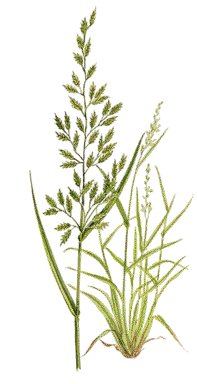Festuca arundinacea (Tall Fescue)
 Tall fescue is a hardy, popular, cool season perennial
grass that can grow on a variety of soils in a variety of climates. It
is grown on an estimated 35 million US acres.
Tall fescue is a hardy, popular, cool season perennial
grass that can grow on a variety of soils in a variety of climates. It
is grown on an estimated 35 million US acres.
*** Image from TIME LIFE Plant Encyclopedia.
Advantages of tall fescue
- Cool season perrenial grass
- High yield
- Drought resistant
- Resistant to overgrazing
- High quality nutrient source
Disadvantages of tall fescue
- alkaloid production by plant itself
- Endophyte infection --> produces even more damaging alkaloids such as the indole alkaloid ergovaline
Managing endophyte-infected tall fescue
Converting endophyte-infected fescue to endophyte-free pasture is a challenging task. Changing to endophyte-free fescue may not be the best idea because the endophyte increases the forage's hardiness and promotes growth on marginal soils.
Another option is to diversify a pasture with other forages. This helps reduce fescue toxicity by diluting the concentration of infected fescue.
Nitrogen fertilization appears to increase ergovaline levels in endophyte-infected fescue. Ergovaline levels also increase as plant matures and seed heads form. Keeping livestock off fescue pastures after seed heads appear is advisable, but not always practical. If you cut tall fescue for hay, do it prior to seed head formation, otherwise the hay and remaining stover will be high in ergovaline.
Eradication
There are three main methods of eliminating endophyte infected
fescue. They all involve eliminating the existing fescue, and replanting
with
endophyte-free
fescue seeds .
- Fastest Method:
- Prevent seedhead formation in spring by mowing.
- In late summer, spray pasture with herbicide, in 2 applications a week apart.
- Plant endophyte-free seed
- There is about 50% chance of endophyte-infected fescue reappearing.
- Intermediate Method:
- Spray fescue with herbicide before seeds form.
- Plow pasture.
- Plant summer annual.
- In fall, spray herbicide on recovering fescue.
- Plant endophyte-free seeds.
- Better chance of killing infected fescue.
- Long Method:
- Late summer or ealy fall, spray with herbicide.
- Plant winter annual: grass and legume or grass with nitrogen fertilizer.
- In spring, spray with fertilizer.
- Late summer or fall, sray with herbicide if necessary, and plant endophyte free seeds.
- Best chance of killing infected fescue.
This series of web pages was created by an undergraduate student at Cornell University for the AS625 class.
WARNING: These web pages are only meant to be informative. Neither Cornell University nor the author of this site endorse or recommend the use of these plants.